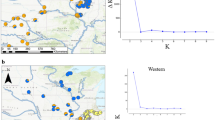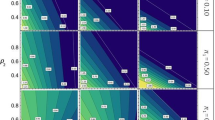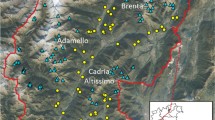Abstract
Associations between heterozygosity and fitness traits have typically been investigated in populations characterized by low levels of inbreeding. We investigated the associations between standardized multilocus heterozygosity (stMLH) in mother trees (obtained from12 nuclear microsatellite markers) and five fitness traits measured in progenies from an inbred Scots pine population. The traits studied were proportion of sound seed, mean seed weight, germination rate, mean family height of one-year old seedlings under greenhouse conditions (GH) and mean family height of three-year old seedlings under field conditions (FH). The relatively high average inbreeding coefficient (F) in the population under study corresponds to a mixture of trees with different levels of co-ancestry, potentially resulting from a recent bottleneck. We used both frequentist and Bayesian methods of polynomial regression to investigate the presence of linear and non-linear relations between stMLH and each of the fitness traits. No significant associations were found for any of the traits except for GH, which displayed negative linear effect with stMLH. Negative HFC for GH could potentially be explained by the effect of heterosis caused by mating of two inbred mother trees (Lippman and Zamir 2006), or outbreeding depression at the most heterozygote trees and its negative impact on the fitness of the progeny, while their simultaneous action is also possible (Lynch. 1991). However,since this effect wasn’t detected for FH, we cannot either rule out that the greenhouse conditions introduce artificial effects that disappear under more realistic field conditions.
Similar content being viewed by others
References
Akaike H (1974) A new look at the statistical model identification. IEEE Trans Autom Control 19:7163–7722
Amos W, Wilmer JW, Fullard K, Burg TM, Croxall JP, Bloch D, Coulson T (2001) The influence of parental relatedness on reproductive success. Proc Roy Soc Lond B Biol 268:2021–2027
Aparicio JM, Ortego J, Cordero PJ (2006) What should we weigh to estimate heterozygosity, alleles or loci? Mol Ecol 15:4659–4665
Aparicio JM, Ortego J, Cordero PJ (2007) Can a simple algebraic analysis predict markers-genome heterozygosity 12 correlations? J Hered 98:93–96
Bäckström A (1995) Sävars bruksepok. In: Skogshistoriska essäer—skrivna av eleverna på kursen. “Skogens och skogsbruketshistoria”, SLU, Umeå, pp 47–51
Balloux F, Amos W, Coulson T (2004) Does heterozygosity estimate inbreeding in real populations? Mol Ecol 13(14):3021–3031
Booy G, Hendriks RJJ, Smulders MJM, Van Groenendael JM, Vosman B (2000) Genetic diversity and the survival 18 of populations. Plant Biol 2:379–395
Boys J, Cherry M, Dayanandan S (2005) Microsatellite analysis reveals genetically distinct populations of red pine (Pinus resinosa Pinaceae). Am J Bot 92:833–841
Britten HB (1996) Meta-analyses of the association between multilocus heterozygosity and fitness. Evolution 50(22):2158–2164
Bush RM, Smouse PE (1991) The impact of electrophoretic genotype on life-history traits in Pinus taeda. Evolution 45:481–498
Bush RM, Smouse PE, Ledig FT (1987) The fitness consequences of multiple-locus heterozygosity -the 26 relationship between heterozygosity and growth-rate in Pitch pine (Pinus rigida Mill). Evolution 41:78727–79828
Chapman JR, Nakagawa S, Coltman DW, Slate J, Sheldon BC (2009) A quantitative review of heterozygosity-fitness correlations in animal populations. Mol Ecol 18:2746–2765
Charlesworth D, Charlesworth B (1987) Inbreeding depression and its evolutionary consequences. Annu Rev Ecol Syst 18:237–268
Charlesworth B, Charlesworth D (1999) The genetic basis of inbreeding depression. Genet Res 74:329–340
Coltman DW, Slate J (2003) Microsatellite measures of inbreeding: a meta-analysis. Evolution 57:971–983
Coulon A (2010) GENHET: an easy-to-use R function to estimate individual heterozygosity. Mol Ecol Resour 10:167–169
Dempster AP, Laird NM, Rubin DB (1977) Maximum likelihood from incomplete data via the EM algorithm. J R Stat Soc B 39:1–38
Deng HW, Fu YX (1998) Conditions for positive and negative correlations between fitness and heterozygosity in equilibrium populations. Genetics 148:1333–1340
Excoffier L, Laval G, Schneider S (2005) Arlequin ver. 3.0: an integrated software package for population genetics data analysis. Evol Bioinform Online 1:47–50
Farris MA, Mitton JB (1984) Population density, outcrossing rate, and heterozygote superiority in Ponderosa pine. Evolution 38:1151–1154
Franklin EC (1970) Survey of mutant forms and inbreeding depression in species of the family Pinaceae. In: USDA Forest Service Research Paper SE-61, June 1970
García-Gil MR, Francois O, Kamruzzahan S, Waldmann P (2009) Joint analysis of spatial genetic structure and inbreeding in a managed population of Scots pine. Heredity 103:90–96
Jourdan-Pineau H, Folly J, Crochet PA, David P (2012) Testing the influence of family structure and outbreeding depression on heterozygosity-fitness correlations in small populations. 66:3624–3631
Kärkkäinen K, Savolainen O, Koski V (2000) Why do plants abort so many developing seeds: bad offspring or bad maternal gentoypes? Evol Ecol 13:305–317
Knowles P, Grant MC (1981) Genetic patterns associated with growth variability in Ponderosa pine. Am J Bot 68:942–946
Koski V (1970) A study of pollen dispersal as a mechanism of gene flow in conifers. Metsatieteellisen tutkimuslaitoksen julkaisuja 70:1–78
Koski V (1971) Embryonic lethals of Picea abies and Pinus sylvestris. Communicationes Instituti Forestalis Fenniae 75: 30
Ledig FT, Guries RP, Bonefeld BA (1983) The relation of growth to heterozygosity in pitch pine. Evolution 37:1227–1238
Leimu R, Mutikainen P, Koricheva J, Fischer M (2006) How general are positive relationships between plant population size, fitness and genetic variation? J Ecol 94:942–952
Lippman ZB, Zamir D (2006) Heterosis: revisiting the magic. Trends Genet 23:60–66
Lunn D, Spiegelhalter D, Thomas A, Best N (2009) The BUGS project: evolution, critique and future directions. Stat Med 28:3049–3067
Lynch M (1991) The genetic interpretation of inbreeding depression and outbreeding depression. Evolution 45:622–629
Lynch M, Walsh B (1998) Genetics and analysis of quantitative traits. Sinauer Associates, Sunderland
Mena-Ali J, Keser LH, Stephenson AG (2008) Inbreeding depression in Solanum carolinense (Solanaceae), a species with a plastic self-incompatibility response. BMC Evol Biol 8:10
Mimura M, Aitken SN (2007) Increased selfing and decreased effective pollen donor number in peripheral relative to central populations in Picea sitchensis (Pinaceae). Am J Bot 94:991–998
Mirov NT (1967) The genus Pinus, p 602
Mitton JB, Andalora R (1981) Genetic and morphological relationships between Blue spruce, Picea pungens, and Engelmann spruce, Picea engelmannii, in the Colorado front range. Can J Bot 59:2088–2094
Mosseler A, Major JE, Rajora OP (2003) Old-growth red spruce forests as reservoirs of genetic diversity and reproductive fitness. Theor Appl Genet 106:931–937
Pemberton J, Coltman D, Coulson T, Slate J (1999) Using microsatellites to measure the fitness consequences of inbreeding and outbreeding. In: Goldstein B, Shclotterer C (eds) Microsatellites: evolution and applications. Oxford university press, New York, pp 151–164
R Development Core Team (2009) R: A Language and Environment for Statistical Computing. R Foundation for Statistical Computing, Vienna
Reed DH, Frankham R (2003) Correlation between fitness and genetic diversity. Conserv Biol 17:230–237
Ritland K (2002) Extensions of models for the estimation of mating systems using n independent loci. Heredity 88:221–228
Robledo-Arnuncio JJ, Alia R, Gil L (2004) Increased selfing and correlated paternity in a small population of a predominantly outcrossing conifer, Pinus sylvestris. Mol Ecol 13:2567–2577
Roles AJ, Conner JK (2008) Fitness effects of mutation accumulation in a natural outbred population of wild radish (Raphanus raphanistrum): comparison of field and greenhouse environments. Evolution 62:1066–1075
Rousset F (2008) GENEPOP ‘ 007: a complete re-implementation of the GENEPOP software for Windows and Linux. Mol Ecol Resour 8:103–106
Rudin D, Eriksson G, Rasmuson M (1977) Inbreeding in a seed tree stand of Pinus sylvestris L, in northern Sweden, a study by the aid of the isozyme technique. Rapporter och Uppsatser, Institutionen for Skogsgenetik, p 45
Sarvas R (1962) Investigations on the flowering and seed crop of Pinus silvestris. Commun Inst Forest Fenn 53:1198
Savolainen O, Hedrick P (1995) Heterozygosity and fitness -no association in scots pine. Genetics 140:755–766
Service PM, Rose MR (1985) Genetic covaration among life-history components: the effect of novel environments. Evolution 39:943–945
Shea KL (1989) The relationship between heterozygosity and fitness in Engelmann spruce and Subalpine fir. Am J Bot 76:153–154
Slate J, David P, Dodds KG, Veenvliet BA, Glass BC, Broad TE, McEwan JC (2004) Understanding the relationship between the inbreeding coefficient and multilocus heterozygosity: theoretical expectations and empirical data. Heredity 93:255–265
Sorensen F (1969) Embryonic genetic load in coastal Douglas fir, Pseudotsuga Menziesii Var, Menziesii. Am Nat 103:389–398
Spiegelhalter DJ, Best NG, Carlin BP, van der Linde A (2002) Bayesian measures of model complexity and fit. J Roy Stat Soc B 64:583–640
Strauss SH (1986) Heterosis at allozyme loci under inbreeding and crossbreeding in Pinus attenuata. Genetics 113:115–134
Strauss SH, Libby WJ (1987) Allozyme heterosis in radiata pine is poorly explained by overdominance. Am Nat 130:879–890
Szulkin M, Bierne N, David P (2010) Heterozygosity-fitness correlations: a time for reappraisal. Evolution 64:1202–1217
Tsitrone A, Rousset F, David P (2001) Heterosis, marker mutational processes and population inbreeding history. Genetics 159:1845–1859
Vogl C, Karhu A, Moran G, Savolainen O (2002) High resolution analysis of mating systems: inbreeding in natural populations of Pinus radiata. J Evol Biol 15:433–439
Acknowledgments
We acknowledge Holmen Skog, especially Erik Normark, for permission to utilize the Scots pine population. We also want to thank Prof. Barbara Giles for useful comments on earlier versions of the manuscript. We thank Skogforsk, Prof. Bengt Andersson and Monica Lundström for providing the seeds and performing the measurements. This work was supported by the Kempe Foundation through the Research School in Forest Genetics and Breeding at The Swedish University of Agricultural Sciences (SLU).
Author information
Authors and Affiliations
Corresponding author
Rights and permissions
About this article
Cite this article
Abrahamsson, S., Ahlinder, J., Waldmann, P. et al. Maternal heterozygosity and progeny fitness association in an inbred Scots pine population. Genetica 141, 41–50 (2013). https://doi.org/10.1007/s10709-013-9704-y
Received:
Accepted:
Published:
Issue Date:
DOI: https://doi.org/10.1007/s10709-013-9704-y




